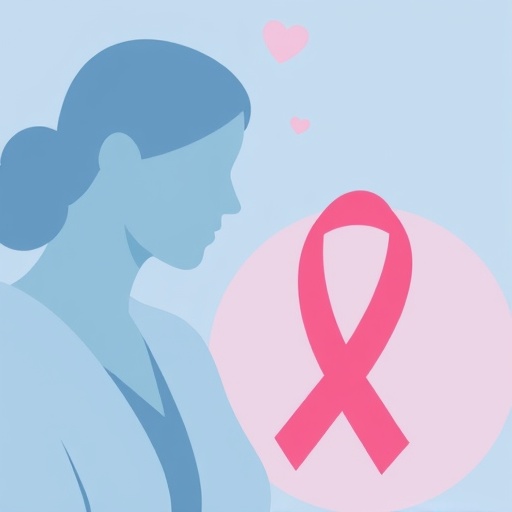In a groundbreaking study, researchers are illuminating the therapeutic potential of chamomile essential oil in the battle against breast cancer, a disease that claims the lives of millions of women globally. Led by Maitisha and colleagues, the comprehensive investigation pulls together principles of network pharmacology to decode the unique mechanisms through which chamomile may exert its beneficial effects. With a focus on integrating traditional herbal remedies with modern scientific approaches, this study stands to redefine how we view natural compounds in oncology.
Chamomile, scientifically known as Matricaria chamomilla, has been cherished for centuries for its calming properties and diverse health benefits. Its essential oil, derived from the flowers, is rich in bioactive compounds, including flavonoids and terpenes, which have demonstrated anti-inflammatory, antioxidant, and even anticancer activities. The exploration of these attributes through sophisticated methodologies such as network pharmacology offers unprecedented insights into how these natural compounds interact within the human body.
In their research, the authors employed network pharmacology as a multipronged approach to analyze the interactions between the constituents of chamomile essential oil and various biological pathways associated with breast cancer. This innovative method allows researchers to visualize and interpret the complex interplay of multiple compounds and target molecules rather than focusing on singular interactions. By applying bioinformatics tools, the team was able to identify key genes and pathways that are modulated by chamomile oil, showcasing its potential as a therapeutic agent.
The study revealed that chamomile essential oil operates through several mechanisms, implementing a multifaceted strategy in targeting cancer cells. In particular, the scientists focused on the inhibition of tumor growth and induction of apoptosis, or programmed cell death, in malignant cells. This dual action is crucial, as apoptosis helps to eliminate potentially harmful cells without affecting healthy ones, increasing the therapeutic index of chamomile oil. The findings suggest that specific components of the oil may enhance these pathways, making it possible to incorporate chamomile into comprehensive cancer treatment regimens.
Furthermore, the research highlights the importance of the antioxidant properties of chamomile. Oxidative stress has long been implicated in the development and progression of cancer. By reducing oxidative damage through its high levels of antioxidants, chamomile essential oil may provide protective effects against tumor development while simultaneously inhibiting cancer cell proliferation. It is thus positioning itself not only as an adjunct therapy but potentially as a preventive measure in at-risk populations.
Given the rising interest in integrative oncology, this study underscores the necessity of validating traditional remedies through scientific inquiry. As patients increasingly seek alternatives and complementary treatments, the endorsement of chamomile essential oil as both safe and effective may resonate well with the public and healthcare providers alike. Comprehensive drug development, however, necessitates a rigorous understanding of dosage, efficacy, and safety, aspects that the research aims to address through controlled trials in the future.
In addition to its anticancer properties, chamomile essential oil exhibits advantages in terms of safety and tolerance. Unlike conventional chemotherapeutic agents, which often come with an array of adverse effects, chamomile oil has a long history of use without significant toxicity when applied appropriately. This aspect could be vital in enhancing patient compliance and quality of life during treatment protocols. The study proposes that incorporating chamomile as a complementary option could aid in alleviating side effects typically experienced during chemotherapy, such as nausea and fatigue, thus providing relief and comfort to patients.
The research team emphasizes the collaborative nature of their findings, calling attention to network pharmacology as a tool that merges disciplines, ranging from traditional medicine to modern science. The integration of these diverse disciplines not only helps validate the ancient wisdom surrounding chamomile but also opens new avenues for its application in clinical practice. As this integrative approach gains traction, it encourages more researchers to adopt comprehensive methods when exploring the pharmacodynamics of other natural compounds.
Challenges do exist, particularly the need for well-designed human clinical trials to substantiate these promising results. While preclinical studies offer hope, they cannot replace the need for empirical evidence derived from human populations. The research team is keenly aware of this requirement, ensuring that their findings will be transitioned from laboratory settings to clinical realities. They envision future studies that will further elucidate the safe and efficacious use of chamomile in diverse cohorts of breast cancer patients.
The implications of these findings are profound — should chamomile essential oil prove effective in larger clinical settings, it could reinvigorate interest in phytotherapy as a legitimate component of cancer treatment. As cancer remains a foremost public health concern, identifying and validating such integrative therapies is crucial to advancing patient care and treatment outcomes. The shift towards holistic approaches not only enriches the therapeutic landscape but also empowers patients to take an active role in their health choices.
Amidst the controversial debates around pharmaceutical treatments, the study of chamomile essential oil invites stakeholders to reconsider and perhaps reintegrate herbal supplements into everyday therapeutic practices. With its storied history and contemporary relevance, chamomile serves as a prime example of how ancient remedies can seamlessly align with modern scientific methodologies to combat some of today’s most pressing health challenges. As patience for conventional treatment wanes among certain demographics, the allure of a more “natural” approach stands to redefine our collective understanding of efficacy.
In summary, the pioneering research conducted by Maitisha and others encapsulates the symbiotic relationship between nature and science, unearthing valuable insights into the potential of chamomile essential oil in the fight against breast cancer. As the study continues to reverberate through the scientific community, it lays the groundwork for further explorations that meld pharmacological innovation with herbal wisdom, signaling a new era of integrative cancer therapy that could benefit countless individuals worldwide.
In closing, the promise shown by chamomile essential oil serves as a reminder of our natural heritage and the wealth of knowledge waiting to be discovered when we dare to look beyond the conventional. The journey of bringing these traditional remedies into the modern therapeutic framework is just beginning; however, the potential rewards are immense, not just for patients, but for the entire healthcare landscape battling against cancer.
Subject of Research: Exploration of chamomile essential oil’s pharmacological action mechanism in breast cancer treatment.
Article Title: Exploring the pharmacological action mechanism of chamomile essential oil on the treatment of breast cancer based on network pharmacology.
Article References: Maitisha, G., Zhou, J., Zhao, Y. et al. Exploring the pharmacological action mechanism of chamomile essential oil on the treatment of breast cancer based on network pharmacology.
BMC Complement Med Ther 25, 382 (2025). https://doi.org/10.1186/s12906-025-05126-z
Image Credits: AI Generated
DOI: 10.1186/s12906-025-05126-z
Keywords: chamomile, essential oil, breast cancer, network pharmacology, phytotherapy, antioxidants, integrative oncology
Tags: anti-inflammatory properties of chamomileantioxidant effects of chamomile oilbioactive compounds in chamomilechamomile oil and breast cancer therapyflavonoids and terpenes in chamomile oilintegrative approaches in breast cancer therapyMatricaria chamomilla health benefitsmechanisms of chamomile in cancer therapynatural compounds in cancer researchnetwork pharmacology in oncologytherapeutic potential of chamomile essential oiltraditional herbal remedies in cancer treatment




